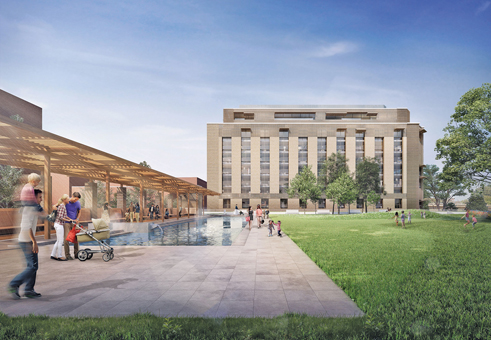Heating Plant Wins Fine Arts Nod

By Brady HoltCurrent Staff Writer
Georgetown’s West Heating Plant project won conceptual approval from the U.S. Commission of Fine Arts last Thursday, a surprising reversal of objections from the panel’s Old Georgetown Board subsidiary.
The project envisions demolishing most of the vacant 1948 industrial building at 29th and K streets NW to construct a luxury condo building with about 60 residential units. The proposed design emulates the heating plant’s shape, but a dressier facade would provide windows for the residences. The Old Georgetown Board last month rejected the plans as insufficiently respectful of the historically protected building, but the development team successfully appealed to the Fine Arts Commission.
Commission secretary Tom Luebke said the proposal presents “kind of a funny hybrid” between reconstructing a historic building and starting from scratch. Presented with such a design, he said, the Old Georgetown Board and Commission of Fine Arts went in opposite directions: the former sought a closer reflection of the existing structure, and the latter encouraged greater deviation.
“The commission … expressed support for the general design direction, and also said they thought the design could be more innovative and expressive, and less literal in its reinterpretation of the building,” Luebke told The Current. However, the changes wouldn’t be as dramatic as an earlier design scheme that fully demolished the heating plant building, as the commission supported plans to retain the existing western facade facing 29th Street, according to Luebke.
The decision was a coup for the project, which has won substantial community support for its goal of transforming a blighted industrial site and providing a public park. Richard Levy of the Levy Group, one of the heating plant developers, had said that the Old Georgetown Board’s requested changes would have made the project unsuitable for residential use. Now, he said in an interview, the Commission of Fine Arts decision exceeded even his optimistic projections.
“Did I expect a unanimous agreement? Did I expect it at the first meeting? The answer is no and no,” Levy said. “To say I was shocked would be an understatement.”
Levy said project architect David Adjaye will revise the designs in the coming weeks to reflect the commission’s request for a “bolder” design, and that he can’t speculate on what the architect will bring back. “David certainly feels unshackled,” said Levy.
The project team hasn’t yet pinned down a revised schedule, but Levy said he hopes the new designs can go before the Fine Arts Commission in July and the D.C. Historic Preservation Review Board in September. The project needs so many approvals because the heating plant is part of the federally protected Georgetown Historic District and also has further protections as a former federal building. Levy said last week’s decision was a major step toward clearing those hurdles.
“It was great to see a body take seriously the issues that we’ve been grappling with, as well as the solutions that have been carefully thought through,” Levy said. “It’s the first time that there’s been that kind of serious involvement, versus reactive negative reaction, and that was reassuring.”
Luebke, the Fine Arts Commission secretary, called it “extremely rare” for the full commission to reverse the advisory opinion of the Old Georgetown Board. “The advantage of having the Old Georgetown Board review things is they know the historic district very well, the details of it,” he said.
The commission did ask developers for revisions to the public park planned for the heating plant’s former coal yard. Commissioners considered the current proposal overly “gardenesque and sweet” for southern Georgetown, Luebke said, and requested that the landscaping reflect some of the area’s historically “gritty industrial character.”
This article appears in the May 24 issue of The Georgetown Current newspaper.
